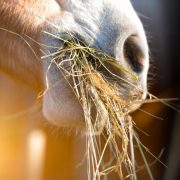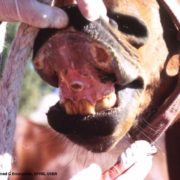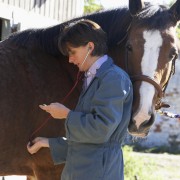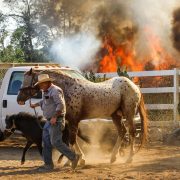Holistic Approach To Gastric Ulcers
/in Uncategorized /by ronstalmanToday more and more horses are diagnosed with gastric ulcers. It’s been well-documented that over 90% of racehorses and over 60% of performance horses (hunter/jumpers, dressage, endurance, and western) have ulcers. New research shows that even small changes in the routine of a pleasure horse can cause ulcers in as little as seven days. If your horse is “emotional,” they can start an ulcer just sitting in their stall. Even diet can play a huge roll in developing ulcers. The point here is that it is not just training, traveling or competitions; there could be several factors in developing ulcers.
FIRST – Know the signs of an ulcer. These include poor performance (could be disguised as muscle or back pain), behavioral issues (poor attitude, resistance, girthy), colic, and loss of weight or condition. If your horse is emotional, they could display a specific sweat pattern on the neck and shoulder area.
TREATMENT – The goal is to balance the gut pH. Traditional therapy would be Omeprazole (Gastrogard); This is a gastric acid pump inhibitor that blocks gastric acid secretion in the stomach. Several words of caution here. First, after using these products, there is a condition called Acid Rebound – a surge in acid production that often happens, causing a significant drop in gastric pH and leaving your horse vulnerable to the formation of new ulcers and digestive discomfort. Second, if used for an extended period, it can inhibit the absorption of key minerals and vitamins, such as magnesium, calcium, vitamin D, and vitamin B12. Calcium, for example, is dependent on gastric acidity; reduction in acidity may interfere with calcium absorption. Finally, Omeprazole can affect the liver and would be contraindicated for horses suffering from liver issues.
HOLISTIC APPROACH – The goal is the same regarding gut pH. Remember, 65% of your horse’s immune system is in their digestive tract; a poor digestive function can also lead to weakened immunity. Through the holistic approach, we support the entire digestive system. Support is provided through a combination of supplements and diet. Balanced Eco Solution has brought together three supplements that assist in clearing ulcers and support the digestive tract.
Body Balance Wellness Formula – A unique blend of nutraceuticals that provide nutrient fortification to strengthen the hindgut. The primary active ingredients in the Wellness Formula are mannan and glucan sugars. Many pathogenic bacteria, viruses, protozoa, fungi, and toxins in the GI tract, and the whole body are attracted to and attach themselves to the mannan sugars. Once attached to the sugars or oligosaccharides, they become inactive, cannot colonize and are rafted out of the body. Also, the Wellness Formula provides a therapeutic dosage of pre and probiotics to add good bacteria back into the gut.
Body Balance Immune Builder – This is a synergistic blend of herbs and honey. It works as an anti-viral, anti-inflammatory, and supports the kidney and liver. The Immune Builder helps horses suffering from ulcers in two ways. First- the honey helps in healing the stomach wall. Second – Marshmallow Root coats the horse’s stomach lining, helping to cover the ulcer, thus protecting it from the digestive stomach acid and soothing the inflamed area. While at the same time allowing the stomach to function normally, by not interfering with the stomach’s natural acidity level and not harming the beneficial microbes in the horse’s gut.
Flaxseed CM – Helps the ulcer horse in several ways. First is the product is “cold-milled.” Cold milling chops the seed without heating the mill blades, so the essential fatty acids remain intact. Second – Flaxseed CM is high in fiber (47%) with a large amount of pectin and mucilage. These water-soluble fibers create a soothing gel inside the digestive tract. Flaxseed is low in sugar and starch (2.6%), making it safe for horses with insulin resistance, PPID (Cushing’s), and PSSM.
Diet – Reduce or eliminate grain concentrated feeds as well as vegetable oils, such as soybean and corn oils, they are great sources of fat but promote inflammation due to their high omega 6 content. Look at vegetable sources that are high in omega 3s such as flax (meal or oil) or chia seeds; these reduce the inflammation experienced with ulcers. Replacing grain concentrated feeds with a Teff hay pellet combined with shredded beet pulp and copra meal or Coolstance works well. If you can’t locate Teff grass or pellets, Timothy grass hay can be substituted.
Ulcer Prevention Checklist
- Feed 30 minutes before exercise. Hay and alfalfa are best as grains pass through the stomach too fast. Forage consumption not only slows the speed of feeding and digesting but also stimulates saliva that acts as a protective buffering agent
- Provide access to hay throughout the day or multiple small meals.
- Avoid physical and behavioral stress.
- Use a natural alternative for long term use of non-steroidal anti-inflammatory drugs such as Phenylbutazone.
RESULTS – Using a pharmaceutical approach, maximum suppression of acid production occurs three to five days after beginning treatment. Using the holistic approach, you can see results in 48 hours or less. Why the faster results using the holistic approach? We are providing the body the nutrition it needs to support the natural healing process instead of a pharmaceutical drug to suppress the symptom.
Vesicular Stomatitisvirus
/in Uncategorized /by ronstalmanDefined, Support Care & Prevention
With more states being added to the list for Vesicular Stomatitis Virus outbreak each day, I felt it was important to let our clients know more about the virus supportive treatment and prevention of this nasty virus.
DEFINED
Vesicular stomatitis typically starts out as a fever and then symptoms such as loss of appetite due to lesions in the mouth and sloughing off the tongue follow. Your horse may also experience lameness if his coronary band develops coronitis. Diagnostics mainly consist of serologic testing for antibodies which can identify which virus is affecting your horse. There is no exact treatment for this condition, but the disease itself is self-limiting. Most horses recover well with very little supportive care making prognosis of recovery good.
SUPPORTIVE CARE
The best way to provide supportive care is by supporting the immune system and treating the lesions as they appear.
Immune Builder
– This is a feed supplement that is formulated to clear the virus from
the bloodstream. It also supports the kidneys and liver during virus
removal. It has both an anti-viral and anti-inflammatory components that
assist in the healing process.
Stall Management
Healthy Stall – Healthy Stall is a perfect 3 in 1 product that provides a clean, natural environment for your horse. Stalls and barns are never parasite free; they are the home to mites, lice, and fleas. These parasites live in the cracks, crevices, and bedding, where they come out at night to feed on the horse. Flies and mosquitoes are a constant nuisance because of the deadly viruses they carry that can affect the long-term healthy of your horse. Essential oils are used for added fly control.
PREVENTION
Fly control is the most important step and should be taken very seriously. We recommend frequent application of fly repellent approved for animals, including on the face and ears. We also advise use of barriers, such as fly sheets and face masks.
In addition, I recommend basic steps to prevent infectious disease when traveling to events with your horse. In a nutshell, these steps are:
- Separate your horse from others during the show.
- Don’t share tack or feeding, watering, and grooming equipment. Don’t tie your horse where others have been tied. Keep hands off other horses and avoid letting other people handle your horse.
- Disinfect all show and travel equipment, including
trailer , before and after use. - Frequently wash hands and use hand sanitizer.
- Keep your traveling horse separate from others for a week after returning home; monitor your horse for any signs of infection or illness during this time.
- Contact your veterinarian for more information
Heath Alert – EHV 1
/in Featured, News /by ronstalmanWe continue to receive outbreak notifications across multiple states of EHV-1 daily. We wanted to help our clients safeguard your horses from being affected. The popular opinion is if my horse is vaccinated, they are safe, right? Unfortunately, no. While there are several vaccines available that protect against respiratory disease and abortion, none are labeled for protection against the neurologic form, and there is no evidence for such protection.
EHV–1 Defined – EHV-1 contagious and spread by direct horse-to-horse contact via the respiratory tract through nasal secretions. It is important to know that this virus can also be spread indirectly through contact with physical objects that are contaminated with the virus — contaminated trailers used for transporting horses.
Signs & Symptoms – The signs the occur with EHV-1 and the EHM strain include things such as decreased coordination, urine dribbling, fever, hind limb weakness, leaning against things to maintain balance, lethargy and the inability to get off the ground.
Traditional Treatment – Treatment is primarily supportive. This includes anti-inflammatory and anticoagulant drugs, and intravenous fluids if the horse has trouble drinking. Nursing care is also extremely important if the horse is unable to rise.
Balanced Eco Solutions EHV Protocol – Our protocol supports the EHV horse in multiple ways. First by building the immune system to clear the virus. Second support the respiratory system. Third, as an anti-inflammatory to deal with the viral side effects. We do this via the three products below.
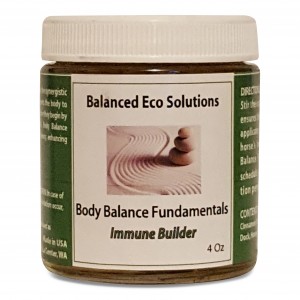
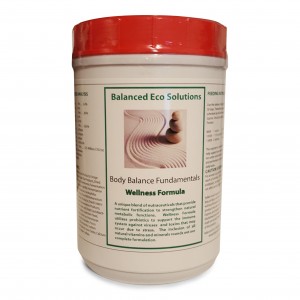
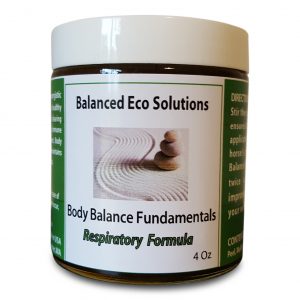
Soaking Vs Steaming Hay to Reduce NSC
/in Featured, News /by ronstalmanIf you have a horse that suffers from Insulin Resistance, Equine Metabolic Syndrome, PSSM or Cushing’s you are always struggling to reduce the NSC levels in their hay. Some owners soak the hay to reduce the sugar levels and airborne respirable dust which naturally occur in the hay. With steaming units becoming more popular it begs the question which method is better to steam or soak?
Soaking the hay in water does reduce the sugar levels, but there are a few issues that need to be addressed. First, if you soak you hay for longer than 2 hours (some will let hay soak all night to reduce feed prep) bacterial growth starts to be a problem. Secondly, soaking causes significant mineral loss, which if left unchecked can cause additional issues. If you have been soaking hay for a while, I would recommend doing an Equine Hair & Mineral Analysis. This is a comprehensive analysis of 15 nutritional elements, 8 toxic metals, 7 significant mineral ratios. From the data, you can pinpoint any mineral imbalance and correct it by creating a custom supplement. Finally, it reduces the amount of dry matter, leaving your horse with less digestible fiber. Another problem with feeding soaked hay is it is not palatable, and horses will refuse to eat it.
Steaming hay does reduce the NSC levels. But it has the added benefit of maintaining the minerals. In fact, since steaming opens up the fiber matrix of hay, the bioavailability of these minerals is likely enhanced. The only mineral that decreased in concentration through steaming was iron, which is a good thing because iron increases insulin resistance.
Finally, we are a proponent of providing metabolic horses a free-choice feed environment instead of a dry paddock. Steaming provides a free-choice to your overweight horse to allow for self-regulation and ultimate weight loss.
Cart
Contact Us
Balanced Eco Solutions
Rochester, Washington U.S.A. 98579
Tel: +1(360) 851-1825
Cel: +1(360) 480-3255
Email: info@balancedecosolutions.com

